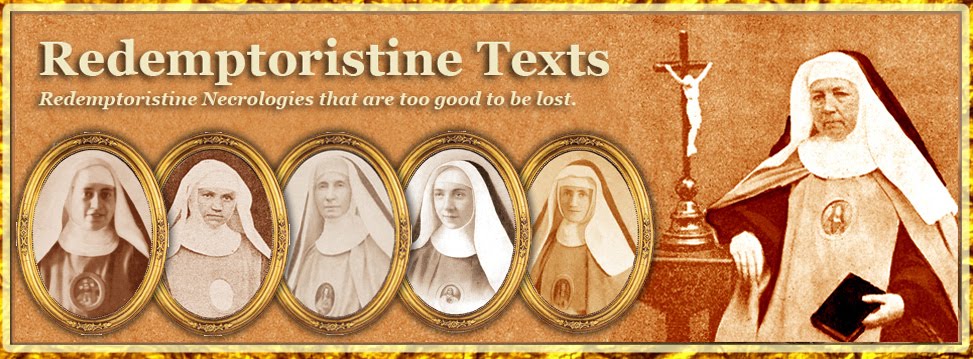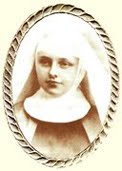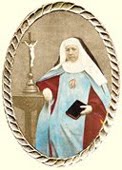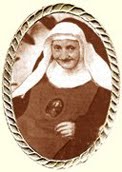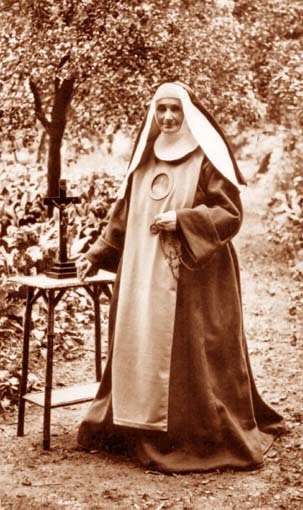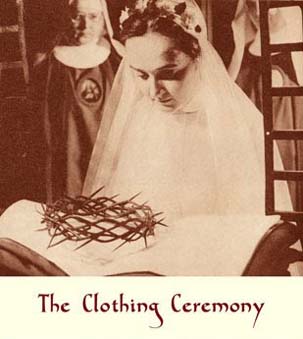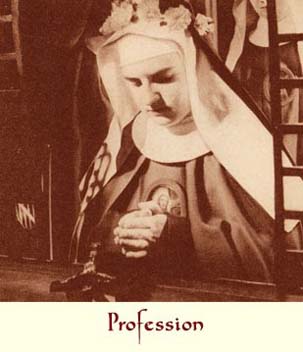Foundation of the Monastery of Dublin
CHAPTER II. The Monastery and the
church of the Redemptoristines of Dublin.
Virtues of the good Mother
CHAPTER II. The Monastery and the
church of the Redemptoristines of Dublin.
Virtues of the good Mother
Twelve years had passed since the entry of the Redemptoristines in Dublin, and they still occupied only a provisional home. In 1871, the moment seemed to have come for Mother Mary-Jean of the Cross to build a definitive Monastery. For this purpose, the Most Rev. Fr. Nicolas Mauron, Rector Major of the Community of the Most Holy Redeemer, wrote to her on 1st January 1872: “I am most happy to bless the enterprise to which, after so many years of waiting, you believe you can now put your hand. You have done well to be patient during so long a time; because, in this kind of business, urgency does not attract God's blessings. For the same reason, you have also done well not to bind yourself too early to begin a foundation in England, especially in a locality that would seem not very desirable. It is important for you to establish yourself well in Dublin, and consolidate yourself well there before beginning any new foundation, of which it would be prudent to dream only when you in fact have a superfluity of good subjects. I would like to hope that this delay according to God's spirit will not be an obstacle to the vocation of the lady you have mentioned to me. A well-established Monastery is worth two which are suffering from the lack of personnel, and which almost always means the decline of observance and the loss of its spirit.”
These beautiful words encouraged the good Superior. The Cardinal Archbishop of Dublin, Mons. Cullen, approved the choice of land, the plan of the monastery and the chapel, drawn up by a famous architect, Mr. Ashlin, and on 18th July 1893, he solemnly laid the first stone of the new convent. A gracious detail: the builder had had the measurements taken of the land that the new monastery and the church would occupy, and the Sisters had pegged them out with long sticks painted white, on each of which they had written an invocation from the Litanies of the Most Holy Virgin. The Most Rev. Fr. Coffin, Provincial of the Redemptorists of England, and Fathers. Bridgett and Harbisons were present, as well as a numerous clergy and a considerable crowd. Once the first stone had been laid, Father Bridgett gave a magnificent speech about the role of the contemplative Orders in the world.
Thanks to the builder’s activity, constantly stimulated by the zeal of the Mother Superior, the work was rapidly brought to a good end. On 30th June 1875, at five o'clock in the morning, the Redemptoristines left their temporary home and went there in procession, led by two eminent members of the clergy, to take possession of their new Monastery. The holy Mass was celebrated, the nuns received communion, and until 2nd July, the convent was open to the crowd avid to visit it. On that day, the Cardinal established the enclosure, and the Sisters, to their greatest joy, withdrew forever into their pious solitude. With what gratitude their hearts now turned towards her who had prepared them a retreat so well adapted to their life of prayer! With what rejoicing they began the Divine Office henceforth in this chapel, a real jewel of art, where their prayers were to attract upon Ireland and the world most abundant favours!
The church merits us spending some moments upon it, for it cost so much work for Mother Mary-Jean of the Cross! She elicited the grants of so many generous souls! She received the visit of so many pious souls, so many hearts that suffered and so many artists anxious to contemplate a masterpiece!
It is dedicated to Saint Alphonsus, and the long street that leads to the Monastery has received the name of Saint Alphonsus Road. The church is indeed worthy of the holy Doctor by its rich ornamentation and the piety that it inspires, for devotion to the Most Holy Sacrament, the Most Holy Virgin, Saint Joseph, the holy Doctor and Saint Gerard Majella seem to have established their home there. The main altar is richly sculptured in white marble; on the front, the Last Supper is engraved in bas-relief and decorated with precious marble. The whole of it is the homage of a pious person totally devoted to Saint Alphonsus.
Around the sanctuary, great pictures represent the holy Doctor preaching to the shepherds and the highlanders of Scala; the Bishop of Saint-Agatha praying before the Blessed Sacrament; and Saint Alphonsus rapt in ecstasy before the picture of the Most Holy Virgin. Above the high altar, Saint Alphonsus is represented glorious in Heaven: he is praying to the Divine Redeemer and pointing with his finger to the Most Holy Virgin who is in an attitude of supplication. At the bottom of the picture, an angel is holding the Rules of the Institute of the Most Holy Redeemer in his hands.
In front of the nuns’ grille, a beautiful painting attracts attention: it is Saint Alphonsus giving the Rule to the Redemptoristine Nuns. The life of the divine Saviour is carved in bas-relief right around the church and below it are the stations of the Way of the Cross. On the window arcades are busts of the twelve apostles, in medallions; then, back to back on columns of marble, the wooden statues of Saint John the Evangelist, Saint Teresa, Saint Francis de Sales and the Irish Saint Bridget, sculptured and ornamented in Munich.
Above the tabernacle rises a dome supported by four columns of red marble: two angels on their knees adore the Blessed Sacrament exposed. The door of the tabernacle is surmounted by a cross decorated with precious stones; inside the door, on a silver plaque, the Sacred Heart of Our Lord is engraved, and it is surrounded with as much hearts as the community possesses members.
A beautiful altar dedicated to Our Lady of Perpetual Help is also the offering of a pious soul. The white marble of which it is made, the mosaics with which it is decorated, the ex-votos of gold and silver that surround it, offer an enchanting vision. Finally the altar of Saint Joseph, also in white marble, completes this beautiful whole.
This is but a feeble and incomplete description: however, it will suffice, we hope, to give an idea of the zeal deployed by Mother Mary-Jean of the Cross, for the beauty of the house of the Lord.
Now let us speak of virtues of the good Superior.
* * * * *
Benefactors are not to be forgotten in a religious Order, and so Mother Mary-Jean of the Cross carefully cultivated this beautiful virtue of gratitude which is so pleasing to both God and men. She prayed and had others pray for all the people who had contributed by their offerings to the building of the monastery and the church, and to its embellishment. The generous O'Brien family was in the first rank and then a noble lady, Mrs. Ainsworth, who was to enter the Monastery later as a nun. Let us speak now of this Sister Mary-Anne Liguori of Jesus Crucified, to whom we shall later dedicate a special note. She entered the Monastery of Dublin, and for five years, gave the example of the most beautiful virtues there. She had the happiness of being attended at her death by her worthy Superior, whose most maternal zeal for the sick and the agonizing we have already praised. Let us listen to Mrs. Ainsworth’s historian on this point. “The maternal love and the assiduous care of the good Superior”, he says, “redoubled when one of her daughters was about to die. She would then install herself in a little room next to the infirmary so as to be close to the dear departing. In spite of her sorrow, in spite of her fatigue, she knew how to remain strong and admirable in this supreme moment. When Sister Mary-Anne Liguori had arrived at her last moments, Mother Mary-Jean of the Cross spoke these sublime words to her: “Finally, my dear Sister, the happy moment has come, and Jesus Himself is coming to find you. The Most Holy Virgin, Saint Joseph and Saint Alphonsus are going to present you to Him. Take your Crucifix that you have loved so much, take your Rosary: these are your passports to eternity.” Then she herself put the blessed candle into the hands of the dying Sister and recited the prayers of the agonising in a gentle and firm voice.”
“A Prioress”, wrote Saint Alphonsus, “must also be a Prioress in love, which means the first in loving God; and this is the ruling that I am giving you.” [1]
Mother Mary-Jean of the Cross was indeed the first to love God while observing her Rule. The beauty of God's house doubtless concerned her to the highest degree, and no one could say what vigilance she exercised so that all was worthy there of the divine Host in the tabernacle and so that the Divine Office would be recited there with piety; but the beauty of the interior house, that is to say the kingdom of God's love in her and in her daughters excited her solicitude even more still. Her devotion to the Blessed Sacrament was exquisite: once she was at the foot of the tabernacle, we may say that no one knew how to draw her away from it. On Holy Thursday, it was with fiery words that she reminded her Sisters of the institution of the Blessed Eucharist; on Good Friday, the Way of the Cross inspired from her the accents of the most tender love towards the divine Master crucified for love of us; in a word, by her words, by her examples and by the good order she established, she preached always and everywhere of this divine love which is sufficient for all and which is perfection itself. And so she spread a delightful peace around herself, and the most tender charity united all hearts to her. The Most Rev. Fr. Mauron congratulated her about it one day in these terms: “I rejoice that all the Sisters are very fervent and united to each other by the spirit of charity; and in a word, occupied in their Monastery by rendering the spiritual edifice ever more perfect by their sanctification, and by knowing and appropriating the spirit of Saint Alphonsus more and more.”
Love of the poor was also a distinctive feature of the worthy Superior. She always took keenly to heart the interests of the poor Irish people, greatly admiring their faith, their respect in God's house, and their patience in their hard privations, and so in winter she distributed many clothes to the poor wretches who implored her charity; and her daughters continued after her this noble exercise in generosity towards Christ's suffering members.
An admirable thing! The worries and the expenses of all kind that the building of her convent imposed on her did not stop her from helping the Redemptoristines of Italy, robbed by the Italian government. The Most Rev. Fr. Mauron congratulated her more than once on this. He wrote to her one day: “I have just received the small sum you are sending to your poor Sisters in Vibonati. Knowing that you have to cope with your building expenses at the moment, I would not have dared to ask or hope for generosity on your part. When I will make known to your Sisters in Vibonati the position in which you find yourself, they will be even more grateful to you because of it.” Another day, he also told her: “I shall send the sum in question to the Superior of Saint-Agatha without delay. It is a great act of charity that you have shown towards this community: it is most pleasing to God and to Saint Alphonsus, and they will certainly bless it. It was thanks to this Monastery, founded and maintained by Saint Alphonsus with so much solicitude, that the Order of the Redemptoristines crossed the mountains and was propagated as far as Dublin. Scala was its cradle, and Saint-Agatha the propagator.”
We have already said how much Mother Mary-Jean of the Cross inspired the love of the Church in her community. Love of the Pope was inseparable from it, and so devotion to the Pope (to use Father Faber’s expression) was fully alive in the monastery. Pius IX, for his part, deigned one day to reply to her in a charming manner. This was in 1867 and the victory of Mentana had just rewarded the bravery of the pontifical warriors. No doubt the good Superior had sent the Sovereign Pontiff the expression of the filial devotion of her community; because the Most Rev. Fr. Mauron wrote to her on the 17th December: “Yesterday I had the honour of being admitted an audience with His Holiness. I then told him, for his consolation, how the Redemptoristines had been praying with fervour and constancy for his sacred person and for the Church, and I asked him for an abundant and special blessing for your community. His Holiness was most happy to oblige. Finally, following your request, I presented him with the enclosed portrait, while asking it to write down some words on it. Immediately, with this very paternal grace that characterizes him, the Holy Father wrote on the back of the picture: Die 16 decemb. 1867. Quocumque tendit Jesus, virgines sequuntur, that is to say: Everywhere Jesus goes, the virgins follow Him. – I do not doubt that these beautiful words that the Holy Father addresses to you directly, will be a fertile topic of meditations for you. Perhaps it will not be indifferent to you to know that the Holy Father looked attentively at the photograph and told me that he thought it was a good one.” [2]
Great was the joy of the community of Dublin when it had the honour of receiving the visit of some delegate of the Holy See. This is how in 1875, on the occasion of the centenary of O'Connell, when Cardinal Franchi was sent by Pius IX to represent him at the splendid feasts celebrating this occasion, it was an indescribable happiness for the community to see this eminent Cardinal coming to speak with a very paternal goodness about the troubles of the Church and the beloved Pontiff. He recommended all the Sisters to pray with ardour for these sacred interests and show themselves, in this as in all the rest, the true daughters of Saint Alphonsus. Then, blessing them as he departed, His Eminence congratulated the Superior for having raised to the glory of God so beautiful a church, and gave her a magnificent cross in memory of his visit.
These beautiful words encouraged the good Superior. The Cardinal Archbishop of Dublin, Mons. Cullen, approved the choice of land, the plan of the monastery and the chapel, drawn up by a famous architect, Mr. Ashlin, and on 18th July 1893, he solemnly laid the first stone of the new convent. A gracious detail: the builder had had the measurements taken of the land that the new monastery and the church would occupy, and the Sisters had pegged them out with long sticks painted white, on each of which they had written an invocation from the Litanies of the Most Holy Virgin. The Most Rev. Fr. Coffin, Provincial of the Redemptorists of England, and Fathers. Bridgett and Harbisons were present, as well as a numerous clergy and a considerable crowd. Once the first stone had been laid, Father Bridgett gave a magnificent speech about the role of the contemplative Orders in the world.
Thanks to the builder’s activity, constantly stimulated by the zeal of the Mother Superior, the work was rapidly brought to a good end. On 30th June 1875, at five o'clock in the morning, the Redemptoristines left their temporary home and went there in procession, led by two eminent members of the clergy, to take possession of their new Monastery. The holy Mass was celebrated, the nuns received communion, and until 2nd July, the convent was open to the crowd avid to visit it. On that day, the Cardinal established the enclosure, and the Sisters, to their greatest joy, withdrew forever into their pious solitude. With what gratitude their hearts now turned towards her who had prepared them a retreat so well adapted to their life of prayer! With what rejoicing they began the Divine Office henceforth in this chapel, a real jewel of art, where their prayers were to attract upon Ireland and the world most abundant favours!
The church merits us spending some moments upon it, for it cost so much work for Mother Mary-Jean of the Cross! She elicited the grants of so many generous souls! She received the visit of so many pious souls, so many hearts that suffered and so many artists anxious to contemplate a masterpiece!
It is dedicated to Saint Alphonsus, and the long street that leads to the Monastery has received the name of Saint Alphonsus Road. The church is indeed worthy of the holy Doctor by its rich ornamentation and the piety that it inspires, for devotion to the Most Holy Sacrament, the Most Holy Virgin, Saint Joseph, the holy Doctor and Saint Gerard Majella seem to have established their home there. The main altar is richly sculptured in white marble; on the front, the Last Supper is engraved in bas-relief and decorated with precious marble. The whole of it is the homage of a pious person totally devoted to Saint Alphonsus.
Around the sanctuary, great pictures represent the holy Doctor preaching to the shepherds and the highlanders of Scala; the Bishop of Saint-Agatha praying before the Blessed Sacrament; and Saint Alphonsus rapt in ecstasy before the picture of the Most Holy Virgin. Above the high altar, Saint Alphonsus is represented glorious in Heaven: he is praying to the Divine Redeemer and pointing with his finger to the Most Holy Virgin who is in an attitude of supplication. At the bottom of the picture, an angel is holding the Rules of the Institute of the Most Holy Redeemer in his hands.
In front of the nuns’ grille, a beautiful painting attracts attention: it is Saint Alphonsus giving the Rule to the Redemptoristine Nuns. The life of the divine Saviour is carved in bas-relief right around the church and below it are the stations of the Way of the Cross. On the window arcades are busts of the twelve apostles, in medallions; then, back to back on columns of marble, the wooden statues of Saint John the Evangelist, Saint Teresa, Saint Francis de Sales and the Irish Saint Bridget, sculptured and ornamented in Munich.
Above the tabernacle rises a dome supported by four columns of red marble: two angels on their knees adore the Blessed Sacrament exposed. The door of the tabernacle is surmounted by a cross decorated with precious stones; inside the door, on a silver plaque, the Sacred Heart of Our Lord is engraved, and it is surrounded with as much hearts as the community possesses members.
A beautiful altar dedicated to Our Lady of Perpetual Help is also the offering of a pious soul. The white marble of which it is made, the mosaics with which it is decorated, the ex-votos of gold and silver that surround it, offer an enchanting vision. Finally the altar of Saint Joseph, also in white marble, completes this beautiful whole.
This is but a feeble and incomplete description: however, it will suffice, we hope, to give an idea of the zeal deployed by Mother Mary-Jean of the Cross, for the beauty of the house of the Lord.
Now let us speak of virtues of the good Superior.
* * * * *
Benefactors are not to be forgotten in a religious Order, and so Mother Mary-Jean of the Cross carefully cultivated this beautiful virtue of gratitude which is so pleasing to both God and men. She prayed and had others pray for all the people who had contributed by their offerings to the building of the monastery and the church, and to its embellishment. The generous O'Brien family was in the first rank and then a noble lady, Mrs. Ainsworth, who was to enter the Monastery later as a nun. Let us speak now of this Sister Mary-Anne Liguori of Jesus Crucified, to whom we shall later dedicate a special note. She entered the Monastery of Dublin, and for five years, gave the example of the most beautiful virtues there. She had the happiness of being attended at her death by her worthy Superior, whose most maternal zeal for the sick and the agonizing we have already praised. Let us listen to Mrs. Ainsworth’s historian on this point. “The maternal love and the assiduous care of the good Superior”, he says, “redoubled when one of her daughters was about to die. She would then install herself in a little room next to the infirmary so as to be close to the dear departing. In spite of her sorrow, in spite of her fatigue, she knew how to remain strong and admirable in this supreme moment. When Sister Mary-Anne Liguori had arrived at her last moments, Mother Mary-Jean of the Cross spoke these sublime words to her: “Finally, my dear Sister, the happy moment has come, and Jesus Himself is coming to find you. The Most Holy Virgin, Saint Joseph and Saint Alphonsus are going to present you to Him. Take your Crucifix that you have loved so much, take your Rosary: these are your passports to eternity.” Then she herself put the blessed candle into the hands of the dying Sister and recited the prayers of the agonising in a gentle and firm voice.”
“A Prioress”, wrote Saint Alphonsus, “must also be a Prioress in love, which means the first in loving God; and this is the ruling that I am giving you.” [1]
Mother Mary-Jean of the Cross was indeed the first to love God while observing her Rule. The beauty of God's house doubtless concerned her to the highest degree, and no one could say what vigilance she exercised so that all was worthy there of the divine Host in the tabernacle and so that the Divine Office would be recited there with piety; but the beauty of the interior house, that is to say the kingdom of God's love in her and in her daughters excited her solicitude even more still. Her devotion to the Blessed Sacrament was exquisite: once she was at the foot of the tabernacle, we may say that no one knew how to draw her away from it. On Holy Thursday, it was with fiery words that she reminded her Sisters of the institution of the Blessed Eucharist; on Good Friday, the Way of the Cross inspired from her the accents of the most tender love towards the divine Master crucified for love of us; in a word, by her words, by her examples and by the good order she established, she preached always and everywhere of this divine love which is sufficient for all and which is perfection itself. And so she spread a delightful peace around herself, and the most tender charity united all hearts to her. The Most Rev. Fr. Mauron congratulated her about it one day in these terms: “I rejoice that all the Sisters are very fervent and united to each other by the spirit of charity; and in a word, occupied in their Monastery by rendering the spiritual edifice ever more perfect by their sanctification, and by knowing and appropriating the spirit of Saint Alphonsus more and more.”
Love of the poor was also a distinctive feature of the worthy Superior. She always took keenly to heart the interests of the poor Irish people, greatly admiring their faith, their respect in God's house, and their patience in their hard privations, and so in winter she distributed many clothes to the poor wretches who implored her charity; and her daughters continued after her this noble exercise in generosity towards Christ's suffering members.
An admirable thing! The worries and the expenses of all kind that the building of her convent imposed on her did not stop her from helping the Redemptoristines of Italy, robbed by the Italian government. The Most Rev. Fr. Mauron congratulated her more than once on this. He wrote to her one day: “I have just received the small sum you are sending to your poor Sisters in Vibonati. Knowing that you have to cope with your building expenses at the moment, I would not have dared to ask or hope for generosity on your part. When I will make known to your Sisters in Vibonati the position in which you find yourself, they will be even more grateful to you because of it.” Another day, he also told her: “I shall send the sum in question to the Superior of Saint-Agatha without delay. It is a great act of charity that you have shown towards this community: it is most pleasing to God and to Saint Alphonsus, and they will certainly bless it. It was thanks to this Monastery, founded and maintained by Saint Alphonsus with so much solicitude, that the Order of the Redemptoristines crossed the mountains and was propagated as far as Dublin. Scala was its cradle, and Saint-Agatha the propagator.”
We have already said how much Mother Mary-Jean of the Cross inspired the love of the Church in her community. Love of the Pope was inseparable from it, and so devotion to the Pope (to use Father Faber’s expression) was fully alive in the monastery. Pius IX, for his part, deigned one day to reply to her in a charming manner. This was in 1867 and the victory of Mentana had just rewarded the bravery of the pontifical warriors. No doubt the good Superior had sent the Sovereign Pontiff the expression of the filial devotion of her community; because the Most Rev. Fr. Mauron wrote to her on the 17th December: “Yesterday I had the honour of being admitted an audience with His Holiness. I then told him, for his consolation, how the Redemptoristines had been praying with fervour and constancy for his sacred person and for the Church, and I asked him for an abundant and special blessing for your community. His Holiness was most happy to oblige. Finally, following your request, I presented him with the enclosed portrait, while asking it to write down some words on it. Immediately, with this very paternal grace that characterizes him, the Holy Father wrote on the back of the picture: Die 16 decemb. 1867. Quocumque tendit Jesus, virgines sequuntur, that is to say: Everywhere Jesus goes, the virgins follow Him. – I do not doubt that these beautiful words that the Holy Father addresses to you directly, will be a fertile topic of meditations for you. Perhaps it will not be indifferent to you to know that the Holy Father looked attentively at the photograph and told me that he thought it was a good one.” [2]
Great was the joy of the community of Dublin when it had the honour of receiving the visit of some delegate of the Holy See. This is how in 1875, on the occasion of the centenary of O'Connell, when Cardinal Franchi was sent by Pius IX to represent him at the splendid feasts celebrating this occasion, it was an indescribable happiness for the community to see this eminent Cardinal coming to speak with a very paternal goodness about the troubles of the Church and the beloved Pontiff. He recommended all the Sisters to pray with ardour for these sacred interests and show themselves, in this as in all the rest, the true daughters of Saint Alphonsus. Then, blessing them as he departed, His Eminence congratulated the Superior for having raised to the glory of God so beautiful a church, and gave her a magnificent cross in memory of his visit.
Footnotes
[1] Letters of St. Alphonsus, Vol. I, p. 421
[2] Le Révérendissime Père Nicolas Mauron, chapitre XX
[2] Le Révérendissime Père Nicolas Mauron, chapitre XX
This necrology is translated from Fleurs de l'Institut des Rédemptoristines by Mr John R. Bradbury. The copyright of this translation is the property of the Redemptoristine Nuns of Maitland, Australia. The integral version of the translated book will be posted here as the necrologies appear.
